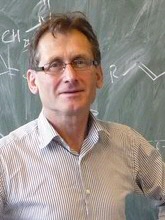A chemically powered unidirectional rotary molecular motor based on a palladium redox cycle

In Nature Chemistry of 8 June 2016 the research group of Ben Feringa presents the design of an organopalladium-based motor and the experimental demonstration of a 360° unidirectional rotary cycle using simple chemical fuels. Exploiting fundamental reactivity principles in organometallic chemistry enables control of directional rotation and offers the potential of harnessing the wealth of opportunities offered by transition-metal-based catalytic conversions to drive motion and dynamic functions.
The conversion of chemical energy to drive directional motion at the molecular level allows biological systems, ranging from subcellular components to whole organisms, to perform a myriad of dynamic functions and respond to changes in the environment. Directional movement has been demonstrated in artificial molecular systems, but the fundamental motif of unidirectional rotary motion along a single-bond rotary axle induced by metal-catalysed transformation of chemical fuels has not been realized, and the challenge is to couple the metal-centred redox processes to stepwise changes in conformation to arrive at a full unidirectional rotary cycle.

a, Blueprint for a 360° unidirectional rotary molecular motor. The upper aryl ring (the ‘rotor’, blue) rotates through 360° in a clockwise sense with respect to the lower aryl ring (the ‘stator’, red). Unidirectional rotation is governed by selective binding of a metal centre and the formation of diastereomeric metal complexes. b, Proposed realization of this system through the combination of biaryl sulfoxide 1 featuring axial and central chirality and a simple palladium salt allowing shuttling between Pd(0) and Pd(II) redox states.

The upper aryl ring (the ‘rotor’, blue) rotates through 360° in a clockwise sense with respect to the lower aryl ring (the ‘stator’, red). Four key steps mediate the rotation: (i) C–H activation; (ii) reintroduction of the C–H bond; (iii) oxidative addition; and (iv) reintroduction of the C–Br bond.
Reference: Beatrice S. L. Collins, Jos C. M. Kistemaker, Edwin Otten & Ben L. Feringa, A chemically powered unidirectional rotary molecular motor based on a palladium redox cycle. Nature Chemistry, 6 June 2016, DOI 10.1038/nchem.2543
Text: Nature.com
More news
-
06 January 2026
Getting to grips with the workhorses of our body
